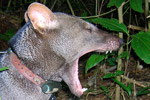
Polar bear in Alaska. Polar bears are the world’s largest land carnivore. Photo by: Alan Wilson/Creative Commons 3.0.
A new study casts doubt on findings from 2013 that hairs from a purported Yeti belonged to an unknown bear species or polar and brown bear hybrid. Instead, two researchers—who took a fresh look at the DNA in question—say the hairs are simply that of a Himalayan brown bear (Ursus arctos isabellinus).
Experts have long believed that the Himalayan brown bear is the real source of the Yeti legends, as many contend that black and brown bears are the source of the Bigfoot legends in North America.
But in 2013 when geneticist Bryan Sykes with Oxford University and his team compared DNA from ‘Yeti’ hairs to actual animals, they found one surprise: two of the hairs were 100 percent match of a polar bear jawbone from 120,000 years ago.
“I don’t think it means there are ancient polar bears wandering around the Himalayas,” Sykes said at the time. “It could mean there is a subspecies of brown bear in the high Himalayas descended from the bear that was the ancestor of the polar bear. Or it could mean there has been more recent hybridization between the brown bear and the descendent of the ancient polar bear.”
But writing in the Proceedings of the Royal Society B, Ceiridwen Edwards and Ross Barnett say their re-analysis of the two hairs in question point to the Himalayan brown bear and not some form of unknown bear. The Himalayan brown bear, which is endangered and elusive, is today found in Pakistan, Nepal, Tibet and India. It is believed to be extinct from Bhutan.
In a response to the paper, Sykes and his team admitted their mistake, calling it “certainly unfortunate.” But they wrote that it did not change the fact that the so-called Yeti hairs were “certainly not from a hitherto unknown primate.” However, they argued againsy the conclusion of Edwards and Barnett that the hairs came from a Himalayan brown bear, but instead contend that it came from a modern day polar bear.
Related articles
|
Bigfoot found? Nope, ‘sasquatch hairs’ come from cows, raccoons, and humans (07/01/2014) Subjecting 30 hairs purportedly from bigfoot, the yeti, and other mystery apes has revealed a menagerie of sources, but none of them giant primates (unless you count humans). Using DNA testing, the scientists undertook the most rigorous and wide-ranging examination yet of evidence of these cryptic—perhaps mythical—apes, according to a new study in the Proceedings of Royal Society B. |
|
Short-eared dog? Uncovering the secrets of one of the Amazon’s most mysterious mammals (07/28/2014) Fifteen years ago, scientists knew next to nothing about one of the Amazon’s most mysterious residents: the short-eared dog. Although the species was first described in 1883 and is considered the sole representative of the Atelocynus genus, biologists spent over a century largely in the dark about an animal that seemed almost a myth. |
|
On babies and motherhood: how giant armadillos are surprising scientists (photos) (07/01/2014) Until ten years ago scientist’s knowledge of the reproductive habits of the giant armadillo— the world’s biggest— were basically regulated to speculation. But a long-term research project in the Brazilian Pantanal is changing that: last year researchers announced the first ever photos of a baby giant armadillo and have since recorded a second birth from another female. |
|
Camera trap captures first ever video of rarely-seen bird in the Amazon…and much more (06/17/2014) A camera trap program in Ecuador’s embattled Yasuni National Program has struck gold, taking what researchers believe is the first ever film of a wild nocturnal curassow (Nothocrax urumutum). In addition, the program has captured video of other rarely-seen animals, including the short-eared dog and the giant armadillo. |
|
Bears, cats, and mystery mammals: camera traps in ‘paper park’ prove it’s worth protecting (06/09/2014) Can a single photograph change the fate of a park? A new conservation group, HabitatID, believes so, and is putting this belief into action. Setting up camera traps in Cambodia’s Virachey National Park, the group hopes that photos of charismatic and endangered species will help reinvigorate protection for a park that has been abandoned by conservation groups and underfunded by the government. |
|
Long lost mammal photographed on camera trap in Vietnam (03/25/2014) In 1929, two sons of Theodore Roosevelt (Teddy Junior and Kermit) led an expedition that killed a barking deer, or muntjac, in present-day Laos, which has left scientists puzzled for over 80 years. At first scientists believed it to be a distinct species of muntjac and named it Roosevelts’ muntjac (Muntiacus rooseveltorum), however that designation was soon cast into doubt with some scientists claiming it was a specimen of an already-known muntjac or a subspecies. The problem was compounded by the fact that the animal simply disappeared in the wild. No one ever documented a living Roosevelts’ muntjac again—until now. |


.150.jpg)


